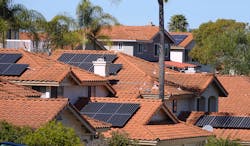SMUD, Rocky Mountain Power: How to create shared value from DERs
Here we look at how Sacramento Municipal Utility District and Rocky Mountain Power are creating shared value from distributed energy resources (DERs) in the West. This is the third article from a new special report about utility value-added services, which includes results from a survey of utility executives about their views on microgrids.
Download the full report.
DERs such as rooftop solar systems and battery storage systems offer three types of value. Two of them — energy generation and demand response capabilities — are already major drivers of DER adoption. However, the third source of value — ancillary grid services such as frequency support — is only beginning to be seized.
“We want to keep costs down while integrating clean resources that reduce carbon emissions and allow for greater reliability and resiliency.”
– James Campbell, director of innovation and sustainability
Those services help conventional electric grids evolve into multidirectional, democratized clean grids of the future, and the publicly owned Sacramento Municipal Utility District (SMUD) and investor-owned Rocky Mountain Power are two utilities pursuing that future through innovative programs that leverage DERs.
Rocky Mountain Power’s Utah service territory includes the Salt Lake City area. Those urban customers are supportive of efforts to decarbonize energy, and the utility seeks creative ways to get funding for programs that will help it move toward the clean energy grid of the future. In November 2021, it announced a $6.42 million grant from the US Department of Energy to develop a “connected community” in Utah.
“We want to keep costs down while integrating clean resources that reduce carbon emissions and allow for greater reliability and resiliency,” James Campbell, director of innovation and sustainability, said when the award was announced. In partnership with Utah State University, the program will allow the utility to use rooftop solar installed at an apartment complex and battery storage systems installed in every apartment in the complex to maximize building, community and grid efficiency. Combined with diverse, flexible end-use equipment, the assets will provide frequency support and other grid services that are so often lacking when high rooftop solar penetration begins to impact grid performance on the local level.
SMUD is taking a step-by-step portfolio of pilot programs approach to unlock the energy generation, demand response and ancillary grid services benefits of DERs for all customers, not just DER owners.
Respondents could have multiple responses
Microgrid Knowledge Utility Executive Survey 2022
The utility offers programs to incentivize residential and commercial owners of battery storage and solar plus storage systems to allow it certain levels of control of those DERs to meet systemwide demand in times of need. In the residential program, storage system owners can get paid for optimizing the battery with SMUD’s Time-of-Day (5-8 p.m.) Rate or paid even more through two additional tiers that allow SMUD to optimize the system to respond to peak demand events during summer months or optimize year-round operation of the storage systems.
To complement its programs, SMUD makes available special rate plans tailored for residential and commercial customers that own storage systems.
SMUD also offers programs that similarly incentivize customers to allow it to control the energy used by water heaters and EV chargers.
In addition to shifting energy to lower demand periods and creating demand response, those programs become building blocks for the next step: virtual power plants.
Launched in 2020, SMUD’s Virtual Power Plant Pilot (VPP) Program created yet another path for customers to receive incentives for sharing the potential of their DERs. By coordinating a fleet of storage systems, water heaters and the like, SMUD aimed to create a VPP that its grid operators could use as a generation resource in times of need.
When residential customers sign up for the two higher tiers of the energy storage incentive program, they are giving SMUD permission to use their storage systems with others as a residential VPP.
“There is a sizable segment of our residential customers who understand the value,” said Patrick McCoy, SMUD strategic business planner. “It’s easy for them to understand the value proposition and, as such, be more willing to participate on the front edge of these virtual power plant programs.”
Download the full report “Exploring the Frontier of Utility Value-Added Services,” courtesy of Enchanted Rock to learn more.
